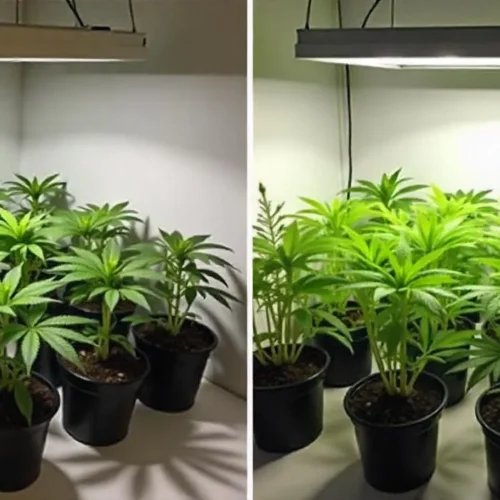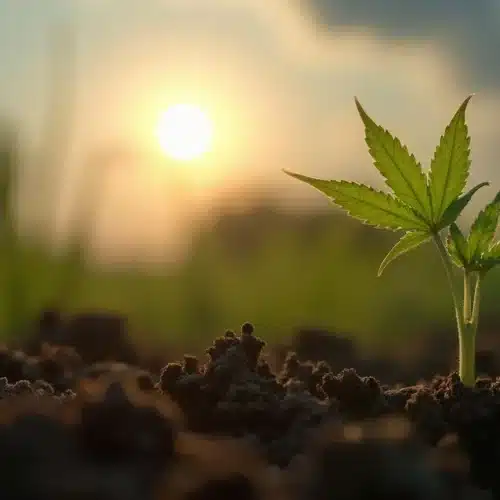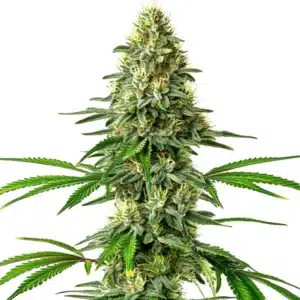Many growers consider powdery mold on cannabis as a type of dry mold due to its ability to spread quickly in low humidity environments. This is because the details matter significantly when identifying and managing powdery mold on cannabis.
Powdery mildew spores don’t need standing water to germinate, only short periods of high humidity. Temporary environmental fluctuations are sufficient for spores to activate, attach to the leaf surface, and begin extracting energy from the plant.
Recommended Strains
LSD Auto
 THC: 23% - 25%
THC: 23% - 25% Type of seed: Autoflowering
Type of seed: Autoflowering Phenotype: Mostly Indica
Phenotype: Mostly Indica Day to flower: 6 - 8 weeks
Day to flower: 6 - 8 weeks
White LSD Auto
 THC: 20% - 24%
THC: 20% - 24% Type of seed: Autoflowering
Type of seed: Autoflowering Phenotype: Mostly Hybrid
Phenotype: Mostly Hybrid Day to flower: 8 - 10 weeks
Day to flower: 8 - 10 weeks
Identifying and Addressing Powdery Mold on Cannabis
What is Cannabis Powdery Mildew?
Cannabis powdery mildew, commonly known as PM among cannabis growers, is a parasitic fungus also referred to as white mold or Oidium. This highly contagious fungal disease spreads rapidly from plant to plant through airborne spores.
The parasitic fungus needs live tissue to grow and reproduce, attacking the aerial parts of cannabis plants, including leaves, stems, and buds. If not treated, powdery mold on cannabis will continuously damage the entire plant, affecting both growth and yield.
Powdery mildew spores can remain dormant for long periods, making future cannabis crops susceptible to the disease if not eradicated. Therefore, prompt action is essential to eliminate the issue.
How to Identify Powdery Mildew on Cannabis
Powdery mildew can affect cannabis plants at any growth stage, though it most commonly infects young plants. This is often due to the high humidity levels required for young plants to thrive, which also create ideal conditions for powdery mildew to spread.
Identifying powdery mildew on cannabis plants is crucial for effective prevention and treatment of the disease.
Key Indicators of Powdery Mold on Cannabis
Powdery Appearance: The primary sign of powdery mold on cannabis is a white or gray powdery substance visible on the plant’s leaves, stems, and buds.
Distorted Growth: This mold can cause leaves to twist, curl, or become deformed.
Yellowing Leaves: As the infection advances, affected leaves may start to turn yellow or brown.
Weak Stems: Powdery mold weakens the stems, making them more prone to breaking.
Promos & Deals
Effective Strategies to Prevent Powdery Mold on Cannabis
Utilize Biofungicides
Biofungicides offer an organic solution for preventing powdery mold on cannabis. Products containing Reynoutria sachalinensis use giant knotweed extract to activate the plant’s natural defense mechanisms, producing biochemicals that combat disease. This induced resistance is not systemic, only protecting the treated area, but it is translaminar, safeguarding both the top and bottom leaf surfaces. New plant growth remains vulnerable, necessitating reapplication every 7 to 14 days to effectively prevent powdery mold on cannabis.
Optimize Air Filtration
Indoor cannabis cultivation often involves closed-loop ventilation systems, which can inadvertently spread powdery mildew spores throughout the grow room. Installing air filters with a MERV rating of 9 or higher can capture these spores, preventing reintroduction into the cultivation area.
Manage Severe Infestations Wisely
Initially removing leaves affected by powdery mildew seems logical, but without following comprehensive preventive measures, leaf removal alone is ineffective. In severe infestations, this practice can worsen the problem by spreading spores through worker contact. Extreme defoliation leaves flowers vulnerable to infection. In such cases, it might be better to scrap the crop to protect the rest of the facility from widespread contamination.
Prevention is Crucial
Prevention is the best defense against powdery mold on cannabis. Since conventional fungicides are often not an option, growers must employ creative and organic methods to safeguard their crops. Implementing these strategies can help maintain a healthy, mold-free cannabis cultivation environment.
Using Leaf Surface pH to Combat Powdery Mold on Cannabis
While completely eradicating powdery mildew spores from the environment may be unfeasible, growers can hinder infections by adjusting leaf surface pH. The establishment of powdery mildew is highly dependent on the pH of the leaf surface, so modifying this can prevent the fungus from thriving on your cannabis plants.
Applying products with potassium bicarbonate can temporarily increase the leaf surface pH, whereas sulfur-containing products will decrease it. Both types of products are approved for organic production, but it is recommended to avoid their use on fully flowering plants. To prevent powdery mildew, consider using these products proactively up to the second week of flowering. Using them beyond this period could compromise the quality of your cannabis.
Avoid Extreme Temperature Fluctuations
To prevent powdery mold on cannabis, maintain a consistent temperature with fluctuations no greater than 15°F between day and night. The ideal temperature range for growing cannabis is between 68°F and 85°F. Minimizing these variations reduces the risk of powdery mildew outbreaks.
Significant temperature swings are a major factor in disease infections for indoor cannabis cultivation. When grow lights turn off, temperatures can drop sharply, causing the air to release moisture as it cools. This creates micro-condensation and high humidity pockets, which are perfect conditions for powdery mildew spores to germinate. While HVAC and dehumidification systems work to stabilize the environment, the spores may have already started to germinate. Wall-mounted fans can spread the spores, and employees may unknowingly transfer them by brushing against plants.
Even short periods of extreme temperature changes, lasting 45 to 60 minutes, can trigger powdery mildew infections despite otherwise stable day and night temperatures.

How to Prevent Powdery Mold on Cannabis Outdoors
Powdery mildew typically affects outdoor cannabis plants during the spring and autumn seasons. Here are additional steps to prevent powdery mildew:
- Remove all dry leaves around your plants.
- If using pots, rotate them regularly to ensure all parts of the plant get sunlight.
- Space your plants adequately to promote good air circulation.
- In the fall, apply biological phytosanitary treatments, especially in areas prone to mist and white fog.
More Advice for Treating Powdery Mildew on Cannabis Plants
How to Get Rid of Powdery Mildew on Leaves
Biofungicides offer an organic solution for preventing and controlling powdery mold on cannabis. Products containing Reynoutria sachalinensis use giant knotweed extract to activate the plant’s natural defense mechanisms, producing biochemicals that combat disease. This induced resistance is not systemic, only protecting the treated area, but it is translaminar, safeguarding both the top and bottom leaf surfaces. Since new plant growth remains vulnerable, growers should reapply treatments every 7 to 14 days to effectively manage and prevent powdery mold on cannabis.
Another effective technique for removing powdery mildew involves washing the leaves with a solution of castile soap and water. This method helps remove powdery mildew without chemicals, making it an excellent option for those who prefer natural remedies. After washing, growers can use a preventative measure such as a bicarbonate powdery mildew spray once a week to further reduce the risk of infections.
How to Get Powdery Mildew off Buds
Removing powdery mildew from buds can be challenging due to their delicate nature. Generally, it’s not recommended to attempt to remove powdery mildew from buds, as the process can damage or contaminate them. Prevention is key to managing powdery mildew on buds.
If powdery mildew does appear on buds, it’s crucial to act quickly to prevent the spread of the disease. One approach is to carefully trim off any visibly infected areas and dispose of them properly. Growers can also use a solution of water and hydrogen peroxide to gently wash the buds, ensuring they are thoroughly dried before storage.
However, it’s important to note that in severe cases, it may not be possible to save infected buds. In such instances, it is better to dispose of them to prevent further contamination of the plant.
Disease Cycle of Powdery Mildew on Cannabis
The lifecycle of powdery mold on cannabis involves both sexual and asexual reproduction. In the asexual phase, conidia (asexual spores) are produced, while the sexual phase generates ascocarps that contain asci and ascospores. Previously known as chasmothecia, cleistothecia, and perithecia, these ascocarps are crucial for powdery mold’s survival without a living host. During the conidial phase, powdery mold on cannabis spreads rapidly, producing vast numbers of spores throughout the growing season. Under favorable conditions, infection can occur within three to seven days, leading to potential epidemic outbreaks due to the swift asexual reproduction.
Sexual reproduction in powdery mildew typically occurs post-flowering or at the end of the growing season. Ascocarps possess natural resistance to drought and low temperatures, allowing them to endure harsh conditions. Genetic recombination during sexual reproduction can produce new genotypes with increased fungicide resistance compared to the parent strains.
New outbreaks of powdery mildew on cannabis can start from ascocarps, especially after the growing season or in spring. Rain or irrigation often triggers the release of ascospores, which can cause primary infections in susceptible host tissues, initiating new epidemics.

LSD Auto
LSD Auto, an automatic version of the renowned LSD feminized strain. This variety was developed by crossing a selected LSD phenotype with Super Magnum Auto, aiming to preserve LSD’s potent qualities while introducing the auto-flowering trait of SMA. The result is a resilient and vigorous plant suitable for both indoor and outdoor cultivation. When grown in spacious pots or directly in the ground, it can achieve heights of up to 120cm.
LSD Auto offers impressive yields, with outdoor plants yielding up to 400g each and indoor setups producing 1.31 – 2.14 oz/ft². Its flowering period spans from 64 to 70 days post-germination, making it a fast and productive option. This mostly Indica strain exhibits exceptional resistance to red spider mites, powdery mildew, and mold, and it can thrive in cooler climates, making it adaptable to various growing environments. Even under adverse weather conditions, LSD Auto consistently delivers rewarding results with minimal effort.
Known for its potent effects, LSD Auto induces a euphoric and psychoactive experience coupled with deep relaxation, both physically and mentally, lasting 2 to 3 hours. Its complex aroma profile combines sweet and floral notes with hints of lemon, pine, and herbal undertones against an earthy backdrop, reminiscent of Skunk and Mazar genetics—qualities often compared to the famous airborne skunk strain. When growing this strain, it’s important to monitor for common issues like powdery mold on cannabis to ensure a healthy and high-quality harvest.
Peyote Cookies
Peyote Cookies is an early indica-dominant strain known for its heavy resin production. It grows compactly and is ideal for novice growers. This strain reaches a height of up to 1 meter and completes its flowering cycle in 8-10 weeks indoors, yielding 51.31 – 1.97 oz/ft². Outdoors, Peyote Cookies impress with harvests of 31 – 35 oz per plant.
Given its dense buds, using meshes or supports is recommended. Alongside its impressive resin output, Peyote Cookies buds exhibit beautiful purple and reddish hues towards the end of flowering. Its strong resistance to molds makes it suitable for both indoor and outdoor cultivation. Outdoor harvesting typically occurs in September in the Northern hemisphere, though good ventilation is advised indoors due to the compactness of its buds. It’s best to avoid excessively humid climates and high temperatures when growing outdoors.
Its flavor profile is reminiscent of guavas, complemented by notes of vanilla and coffee. The effect is deeply relaxing and long-lasting.
Tropicana Cookies Purple Auto
Tropicana Cookies Purple Auto presents excellent growth potential. This auto-flowering variety, stands out for its citrusy profile, deriving from Tropicana Cookies x OG Kush auto lineage. Known for its distinctive orange sorbet aroma, this non-photodependent cannabis strain can achieve a significant size with ease, thriving under good cultivation conditions.
Tropicana Cookies Purple Auto develops robustly with thick branches, benefiting from staking once flowering starts to support its potential yield of up to of high-quality dry bud, with moderate nutrient requirements. Indoor cultivation can yield up to 1.47 – 1.82 oz/ft².
This strain exhibits high resistance to fungi like powdery mold, particularly botrytis. The sweet smoke and intense orange aroma make it appealing to the palate, offering an uplifting effect suitable for any time of day without physical heaviness.

FAQs about Powdery Mold on Cannabis
How Can I Identify Powdery Mildew on Cannabis Plants?
Powdery mold on cannabis appears as white or gray powdery spots on leaves, stems, and buds. Early signs include small, circular patches that can spread rapidly. As the infection progresses, leaves may yellow, curl, or become deformed. Regular inspection of plants, especially in humid conditions, is essential for early detection and effective management of this fungal disease.
What Are the Primary Causes of Powdery Mildew in Cannabis Cultivation?
Powdery mildew thrives in warm, humid environments with poor air circulation. Factors such as overcrowded plants, inadequate ventilation, and fluctuating humidity levels create ideal conditions for its development. Additionally, spores can spread through the air, water, and contaminated tools, making cleanliness and environmental control vital in preventing outbreaks.
What Steps Can Be Taken to Prevent Powdery Mildew on Cannabis?
To prevent powdery mildew, maintain proper air circulation and control humidity levels within the grow area. Regularly inspect plants for early signs of infection and remove affected areas promptly. Utilizing biofungicides can also help protect plants. Ensuring cleanliness of tools and equipment further reduces the risk of spreading spores.


















